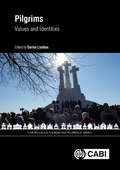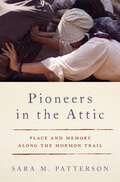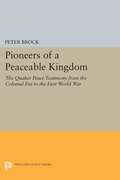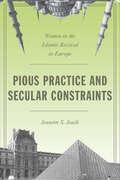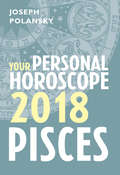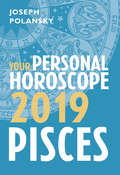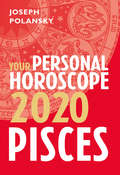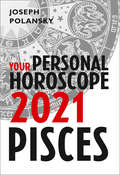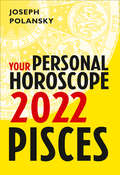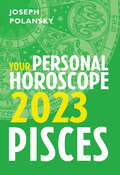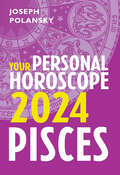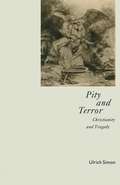- Table View
- List View
Pilgrims Until We Die: Unending Pilgrimage in Shikoku
by Ian Reader John ShultzThe Shikoku pilgrimage, a 1400 kilometre, eighty-eight temple circuit around Japan's fourth largest island, takes around forty days by foot, or one week by car. Historically, Buddhist ascetics walked it without ceasing, creating a tradition of unending pilgrimage that continues in the present era, both by pilgrims on foot and by others in cars. Some spend decades walking the pilgrimage, while others drive it repeatedly, completing hundreds of pilgrimage circuits. Most are retired and make the pilgrimage the centre of their post-work lives. Others who work full-time spend their holidays and weekends as pilgrims. Some have only done the pilgrimage a few times but already imagine themselves as unending pilgrims and intend to do it "until we die". They talk happily of being addicted and having Shikokuby?, 'Shikoku illness', portraying this 'illness' and addiction as blessings. Featuring extensive fieldwork and interviews, this study of Japan's most famous Buddhist pilgrimage presents new theoretical perspectives on pilgrimage in general, along with rich ethnographic examples of pilgrimage practices in contemporary Japan. Pilgrims Until We Die counteracts normative portrayals of pilgrimage as a transient activity, defined by a temporary leave of absence from home to visit sacred places outside the parameters of everyday life, showing that many participants view pilgrimage as a way of creating a sense of home and permanence on the road. Examining how obsession, devotion, and a sense of addiction aided by modern developments and economic factors have created a culture of recurrent pilgrimage, Pilgrims Until We Die challenges standard understandings of pilgrimage.
Pilgrims: Values And Identities (CABI Religious Tourism and Pilgrimage Series)
by Ali Thompson María Ángeles Antelo Pedro Azevedo Derek Dalton Luciana Thais Gonzalez Rubén C. Lois-González Luis Alfonso Gómez Rami Isaac Elyor E. Karimov Kumi Kato Dr Lucrezia Lopez Dane Munro Dr Daniel H Olsen Josephine Pryce Ricardo Nicolas Progano Xerardo Pereiro Kip Redick Larry Russell Pravin S. Rana Rana P. Singh Xosé M. Santos Augusta X. Thomson Dallen J Timothy Slawoj Tanas Shin YasudaValues-rich journeys can be described as pilgrimage, spiritual travel, personal heritage tourism, holistic tourism, and valuistic journeys. There are many motivations for undertaking these journeys; the most important being personal values, life experience, personal and social identity, lifestyle, social and cultural influence. This book presents contributions that address pilgrim motivation, identity and values as they are shaped by the broader sociological, psychological, cultural and environmental perspectives. The focus of the book is the travellers themselves and their inner world through the lens of their pilgrimage. The research presented focuses on the typology of pilgrim journeys as ways in which identity and values are presented to a post-modern consumer society, providing interesting and challenging perspectives on the identity of pilgrims in the 21st century. The book: - Provides a framework for understanding the impact of values and identity on the motivation and behaviour of contemporary pilgrims. - Presents a comprehensive review of the latest research, a collection of case studies and models of practical applications. - Discusses the perceptions of tourism and pilgrimage in the age of value transformations and identity challenges.
The Pillar and Ground of the Truth: An Essay in Orthodox Theodicy in Twelve Letters (PDF)
by Pavel Florensky Boris Jakim Richard F. GustafsonPavel Florensky--certainly the greatest Russian theologian of the last century--is now recognized as one of Russia's greatest polymaths. Known as the Russian Leonardo da Vinci, he became a Russian Orthodox priest in 1911, while remaining deeply involved with the cultural, artistic, and scientific developments of his time. Arrested briefly by the Soviets in 1928, he returned to his scholarly activities until 1933, when he was sentenced to ten years of corrective labor in Siberia. There he continued his scientific work and ministered to his fellow prisoners until his death four years later. This volume is the first English translation of his rich and fascinating defense of Russian Orthodox theology. Originally published in 1914, the book is a series of twelve letters to a "brother" or "friend," who may be understood symbolically as Christ. Central to Florensky's work is an exploration of the various meanings of Christian love, which is viewed as a combination of philia (friendship) and agape (universal love). Florensky is perhaps the first modern writer to explore the so-called "same-sex unions," which, for him, are not sexual in nature. He describes the ancient Christian rites of the adelphopoiesis (brother-making), joining male friends in chaste bonds of love. In addition, Florensky is one of the first thinkers in the twentieth century to develop the idea of the Divine Sophia, who has become one of the central concerns of feminist theologians.
Pine Country Cowboy: The Shepherd's Bride Rescued By The Firefighter Pine Country Cowboy (Mills And Boon Love Inspired Ser.)
by Glynna KayeNo Place Like Home
The Pinecone: The Story Of Sarah Losh, Forgotten Romantic Heroine -- Antiquarian, Architect, And Visionary
by Jenny UglowIn the village of Wreay, near Carlisle, stands the strangest and most magical church in Victorian England. This vivid, original book tells the story of its builder, Sarah Losh, strong-willed and passionate and unusual in every way. Born into an old Cumbrian family, heiress to an industrial fortune, Sarah combined a zest for progress with a love of the past. In the church, her masterpiece, she let her imagination flower - there are carvings of ammonites, scarabs and poppies; an arrow pierces the wall as if shot from a bow; a tortoise-gargoyle launches itself into the air. And everywhere there are pinecones, her signature in stone. The church is a dramatic rendering of the power of myth and the great natural cycles of life and death and rebirth.Sarah's story is also that of her radical family - friends of Wordsworth and Coleridge; of the love between sisters and the life of a village; of the struggle of the weavers, the coming of the railways, the findings of geology and the fate of a young northern soldier in the Afghan war. Above all, though, it is about the joy of making and the skill of local, unsung craftsmen.
Pioneers in the Attic
by Sara M. PattersonWhy do thousands of Mormons devote their summer vacations to following the Mormon Trail? Why does the Church of Jesus Christ of Latter-day Day Saints spend millions of dollars to build monuments and Visitor Centers that believers can visit to experience the history of their nineteenth-century predecessors who fled westward in search of their promised land? Why do so many Mormon teenagers dress up in Little-House-on-the-Prairie-style garb and push handcarts over the highest local hills they can find? And what exactly is a "traveling Zion"? In Pioneers in the Attic, Sara Patterson analyzes how and why Mormons are engaging their nineteenth-century past in the modern era, arguing that as the LDS community globalized in the late twentieth and early twenty-first centuries, its relationship to space was transformed. Following their exodus to Utah, nineteenth-century Mormons believed that they must gather together in Salt Lake Zion - their new center place. They believed that Zion was a place you could point to on a map, a place you should dwell in to live a righteous life. Later Mormons had to reinterpret these central theological principles as their community spread around the globe, but to say that they simply spiritualized concepts that had once been understood literally is only one piece of the puzzle. Contemporary Mormons still want to touch and to feel these principles, so they mark and claim the landscapes of the American West with versions of their history carved in stone. They develop rituals that allow them not only to learn the history of the nineteenth-century journey west, but to engage it with all of their senses. Pioneers in the Attic reveals how modern-day Mormons have created a sense of community and felt religion through the memorialization of early Mormon pioneers of the American West, immortalizing a narrative of shared identity through an emphasis on place and collective memory.
Pioneers in the Attic
by Sara M. PattersonWhy do thousands of Mormons devote their summer vacations to following the Mormon Trail? Why does the Church of Jesus Christ of Latter-day Day Saints spend millions of dollars to build monuments and Visitor Centers that believers can visit to experience the history of their nineteenth-century predecessors who fled westward in search of their promised land? Why do so many Mormon teenagers dress up in Little-House-on-the-Prairie-style garb and push handcarts over the highest local hills they can find? And what exactly is a "traveling Zion"? In Pioneers in the Attic, Sara Patterson analyzes how and why Mormons are engaging their nineteenth-century past in the modern era, arguing that as the LDS community globalized in the late twentieth and early twenty-first centuries, its relationship to space was transformed. Following their exodus to Utah, nineteenth-century Mormons believed that they must gather together in Salt Lake Zion - their new center place. They believed that Zion was a place you could point to on a map, a place you should dwell in to live a righteous life. Later Mormons had to reinterpret these central theological principles as their community spread around the globe, but to say that they simply spiritualized concepts that had once been understood literally is only one piece of the puzzle. Contemporary Mormons still want to touch and to feel these principles, so they mark and claim the landscapes of the American West with versions of their history carved in stone. They develop rituals that allow them not only to learn the history of the nineteenth-century journey west, but to engage it with all of their senses. Pioneers in the Attic reveals how modern-day Mormons have created a sense of community and felt religion through the memorialization of early Mormon pioneers of the American West, immortalizing a narrative of shared identity through an emphasis on place and collective memory.
Pioneers of a Peaceable Kingdom: The Quaker Peace Testimony from the Colonial Era to the First World War
by Peter BrockExtracted from Pacifism in the United States, this work focuses on the significant contribution of the Quakers to the history of pacifism in the United States.Originally published in 1971.The Princeton Legacy Library uses the latest print-on-demand technology to again make available previously out-of-print books from the distinguished backlist of Princeton University Press. These editions preserve the original texts of these important books while presenting them in durable paperback and hardcover editions. The goal of the Princeton Legacy Library is to vastly increase access to the rich scholarly heritage found in the thousands of books published by Princeton University Press since its founding in 1905.
Pious Fashion: How Muslim Women Dress (PDF)
by Elizabeth BucarFor many Westerners, the veil is the ultimate sign of women’s oppression. But Elizabeth Bucar’s take on Muslim women’s clothing is a far cry from this attitude. She invites readers to join her in three Muslim-majority nations as she surveys pious fashion from head to toe and shows how Muslim women approach the question “What to wear?” with style.
Pious Fashion: How Muslim Women Dress
by Elizabeth BucarFor many Westerners, the veil is the ultimate sign of women’s oppression. But Elizabeth Bucar’s take on Muslim women’s clothing is a far cry from this attitude. She invites readers to join her in three Muslim-majority nations as she surveys pious fashion from head to toe and shows how Muslim women approach the question “What to wear?” with style.
Pious Peripheries: Runaway Women in Post-Taliban Afghanistan
by Sonia Ahsan-TirmiziThe Taliban made piety a business of the state, and thereby intervened in the daily lives and social interactions of Afghan women. Pious Peripheries examines women's resistance through groundbreaking fieldwork at a women's shelter in Kabul, home to runaway wives, daughters, mothers, and sisters of the Taliban. Whether running to seek marriage or divorce, enduring or escaping abuse, or even accused of singing sexually explicit songs in public, "promiscuous" women challenge the status quo—and once marked as promiscuous, women have few resources. This book provides a window into the everyday struggles of Afghan women as they develop new ways to challenge historical patriarchal practices. Sonia Ahsan-Tirmizi explores how women negotiate gendered power mechanisms, notably those of Islam and Pashtunwali. Sometimes defined as an honor code, Pashtunwali is a discursive and material practice that women embody through praying, fasting, oral and written poetry, and participation in rituals of hospitality and refuge. In taking ownership of Pashtunwali and Islamic knowledge, in both textual and oral forms, women create a new supportive community, finding friendship and solidarity in the margins of Afghan society. So doing, these women redefine the meanings of equality, honor, piety, and promiscuity in Afghanistan.
Pious Practice and Secular Constraints: Women in the Islamic Revival in Europe
by Jeanette S. JouiliThe visible increase in religious practice among young European-born Muslims has provoked public anxiety. New government regulations seek not only to restrict Islamic practices within the public sphere, but also to shape Muslims', and especially women's, personal conduct. Pious Practice and Secular Constraints chronicles the everyday ethical struggles of women active in orthodox and socially conservative Islamic revival circles as they are torn between their quest for a pious lifestyle and their aspirations to counter negative representations of Muslims within the mainstream society. Jeanette S. Jouili conducted fieldwork in France and Germany to investigate how pious Muslim women grapple with religious expression: for example, when to wear a headscarf, where to pray throughout the day, and how to maintain modest interactions between men and women. Her analysis stresses the various ethical dilemmas the women confronted in negotiating these religious duties within a secular public sphere. In conversation with Islamic and Western thinkers, Jouili teases out the important ethical-political implications of these struggles, ultimately arguing that Muslim moral agency, surprisingly reinvigorated rather than hampered by the increasingly hostile climate in Europe, encourages us to think about the contribution of non-secular civic virtues for shaping a pluralist Europe.
Pisces 2018: Your Personal Horoscope
by Joseph PolanskyYour guide to the year 2018. This fantastic book includes month-by-month forecasts and all you need to know to find out what is in store for you in the year ahead. The only horoscope you’ll ever need.
Pisces 2019: Your Personal Horoscope
by Joseph PolanskyYour guide to the year 2019. This fantastic book includes month-by-month forecasts and all you need to know to find out what is in store for you in the year ahead. The only horoscope you’ll ever need.
Pisces 2020: Your Personal Horoscope
by Joseph PolanskyYour guide to the year 2020. This fantastic book includes month-by-month forecasts and all you need to know to find out what is in store for you in the year ahead. The only horoscope you’ll ever need.
Pisces 2021: Your Personal Horoscope
by Joseph PolanskyYour guide to the year 2021. This fantastic book includes month-by-month forecasts and all you need to know to find out what is in store for you in the year ahead. The only horoscope you’ll ever need.
Pisces 2022: Your Personal Horoscope
by Joseph PolanskyYour guide to the year 2022. This fantastic book includes month-by-month forecasts and all you need to know to find out what is in store for you in the year ahead. The only horoscope you’ll ever need.
Pisces 2023: Your Personal Horoscope
by Joseph PolanskyYour complete one-volume guide to the year 2023. This fantastic and in-depth book includes month-by-month forecasts for every sign and all you need to know to find out what is in store for you in the year ahead. The only one-volume horoscope you’ll ever need.
Pisces 2024: Your Personal Horoscope
by Joseph PolanskyYour complete one-volume guide to the year 2024. This fantastic and in-depth book includes month-by-month forecasts for every sign and all you need to know to find out what is in store for you in the year ahead. The only one-volume horoscope you’ll ever need.
Pisces 2025: Your Personal Horoscope
by null Lars MellisYour complete one-volume guide to the year 2025. This fantastic and in-depth book includes month-by-month forecasts for every sign and all you need to know to find out what is in store for you in the year ahead. The only one-volume horoscope you’ll ever need. Your essential guide to love, life and career success in 2025. This popular, complete one-volume guide contains all you need to know about your personal horoscope for the year 2025. Be prepared for the forthcoming year with monthly predictions for your own sign and discover how to maximise your opportunities and potential to make the most of 2025. This bestselling astrological guide contains: A personality profile for each sign A forecast for the year ahead – what you can expect in terms of wealth, home, health, social and love life A month-by-month forecast of your best days and worst days – the ideal days to attract love, money or success, and when it’s better to just stay in bed!
Pistis Sophia: The Gnostic Tradition of Mary Magdalene, Jesus, and His Disciples
by G. R. MeadA document of paramount historical importance, not only in terms of Christianity but also with respect to the development of Western religion. It chronicles the teachings of Jesus, who explains life's mysteries to his disciples and Mary Magdalene. Their discussions take place after Christ's resurrection and include accounts of his ascension into heaven.
The Pitcher is Broken: Memorial Essays for Gösta W. Ahlström (The Library of Hebrew Bible/Old Testament Studies)
by Steven W. Holloway Lowell K. HandyThis is a volume of tributes and essays in memory of G÷sta W. Ahlstr÷m, Professor of Old Testament in the Divinity School and Near Eastern Languages and Civilizations Department of the University of Chicago. Nineteen essays written by former students and colleagues deal with the history and archaeology of Iron Age Palestine and the ancient Near East, the Deuteronomistic History, and the history of Old Testament studies. Six tributes read at his memorial service, his final bibliography and a list of the dissertations he chaired combine to yield a montage of the scholar as teacher, character, and friend.
The Pitfalls of Piety for Married Women: Two Precious Scrolls of the Ming Dynasty
by Wilt L. IdemaThe Pitfalls of Piety for Married Women shows how problematic the practice of Buddhist piety could be in late imperial China. Two thematically related "precious scrolls" (baojuan) from the Ming dynasty, The Precious Scroll of the Red Gauze and The Precious Scroll of the Handkerchief, illustrate the difficulties faced by women whose religious devotion conflicted with the demands of marriage and motherhood.These two previously untranslated texts tell the stories of married women whose piety causes them to be separated from their husbands and children. While these women labor far away, their children are cruelly abused by murderous stepmothers. Following many adventures, the families are reunited by divine intervention and the evil stepmothers get their just deserts. While the texts in The Pitfalls of Piety for Married Women praise Buddhist piety, they also reveal many problems concerning married women and mothers.Wilt L. Idema's translations are preceded by an introduction that places these scrolls in the context of Ming dynasty performative literature, vernacular literature, and popular religion. Set in a milieu of rich merchants, the texts provide a unique window to family life of the time, enriching our understanding of gender during the Ming dynasty. These popular baojuan offer rare insights into lay religion and family dynamics of the Ming dynasty, and their original theme and form enrich our understanding of the various methods of storytelling that were practiced at the time.
Pitfalls of Scholarship: Lessons from Islamic Studies
by Ahmad Atif AhmadPitfalls of Scholarship offers an array of reflections on higher education, its entanglements with humanity's pursuit of natural and social knowledge, and the impact national environments have upon it. This book considers the humanities, vocational, and scientific/technological sides of the university from the vantage-point of an Islamic studies scholar in twenty-first century American academia. Four discussions and a personal note make up the parts of these pages. The first discussion sets the stage with a description of the irregularities of our age of late modernity and the limits of scholarship in it. The second focuses on clashes of personal and academic knowledge with social assumptions and convictions. Guiding the discussion is an unlikely narrative from an old era where academic freedom did not exist. The third discussion points to the surprisingly negative impacts of obsession with research methods in the modern academy. "Scholarships of negation" are identified as the main illness of the age, next to popular exaggerations of the value of standard assumptions and excellent academic institutions. The fourth and final section deals with modern education's aspiration toward acquiring democratic quality, and the implications of further democratization of education.

